ESP Abarth 500 2016 Owner handbook (in English)
[x] Cancel search | Manufacturer: ABARTH, Model Year: 2016, Model line: 500, Model: Abarth 500 2016Pages: 215, PDF Size: 19.08 MB
Page 5 of 215
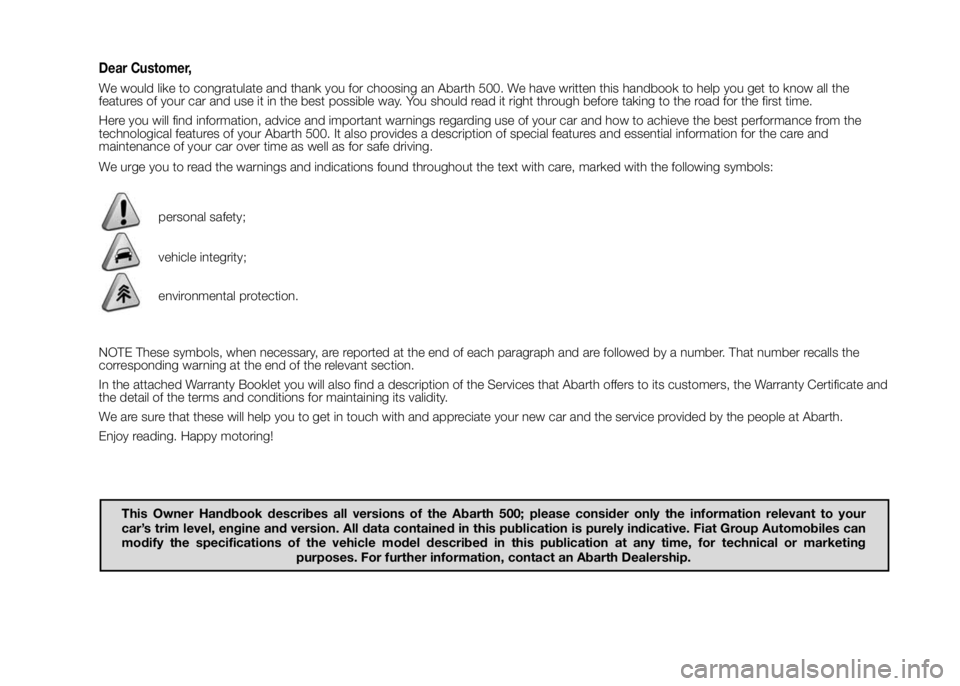
Dear Customer,
We would like to congratulate and thank you for choosing an Abarth 500. We have written this handbook to help you get to know all the
features of your car and use it in the best possible way. You should read it right through before taking to the road for the first time.
Here you will find information, advice and important warnings regarding use of your car and how to achieve the best performance from the
technological features of your Abarth 500. It also provides a description of special features and essential information for the care and
maintenance of your car over time as well as for safe driving.
We urge you to read the warnings and indications found throughout the text with care, marked with the following symbols:
personal safety;
vehicle integrity;
environmental protection.
NOTE These symbols, when necessary, are reported at the end of each paragraph and are followed by a number. That number recalls the
corresponding warning at the end of the relevant section.
In the attached Warranty Booklet you will also find a description of the Services that Abarth offers to its customers, the Warranty Certificate and
the detail of the terms and conditions for maintaining its validity.
We are sure that these will help you to get in touch with and appreciate your new car and the service provided by the people at Abarth.
Enjoy reading. Happy motoring!
This Owner Handbook describes all versions of the Abarth 500; please consider only the information relevant to your
car’s trim level, engine and version. All data contained in this publication is purely indicative. Fiat Group Automobiles can
modify the specifications of the vehicle model described in this publication at any time, for technical or marketing
purposes. For further information, contact an Abarth Dealership.
Page 6 of 215
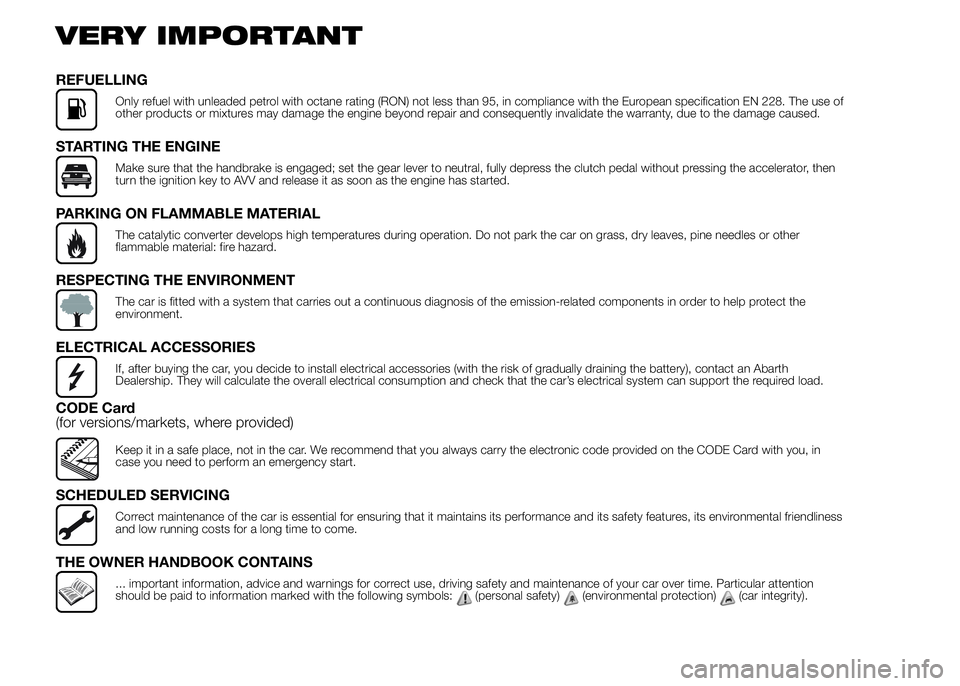
VERY IMPORTANT
REFUELLING
Only refuel with unleaded petrol with octane rating (RON) not less than 95, in compliance with the European specification EN 228. The use of
other products or mixtures may damage the engine beyond repair and consequently invalidate the warranty, due to the damage caused.
STARTING THE ENGINE
Make sure that the handbrake is engaged; set the gear lever to neutral, fully depress the clutch pedal without pressing the accelerator, then
turn the ignition key to AVV and release it as soon as the engine has started.
PARKING ON FLAMMABLE MATERIAL
The catalytic converter develops high temperatures during operation. Do not park the car on grass, dry leaves, pine needles or other
flammable material: fire hazard.
RESPECTING THE ENVIRONMENT
The car is fitted with a system that carries out a continuous diagnosis of the emission-related components in order to help protect the
environment.
ELECTRICAL ACCESSORIES
If, after buying the car, you decide to install electrical accessories (with the risk of gradually draining the battery), contact an Abarth
Dealership. They will calculate the overall electrical consumption and check that the car’s electrical system can support the required load.
CODE Card
(for versions/markets, where provided)
Keep it in a safe place, not in the car. We recommend that you always carry the electronic code provided on the CODE Card with you, in
case you need to perform an emergency start.
SCHEDULED SERVICING
Correct maintenance of the car is essential for ensuring that it maintains its performance and its safety features, its environmental friendliness
and low running costs for a long time to come.
THE OWNER HANDBOOK CONTAINS
... important information, advice and warnings for correct use, driving safety and maintenance of your car over time. Particular attention
should be paid to information marked with the following symbols:(personal safety)(environmental protection)(car integrity).
Page 17 of 215
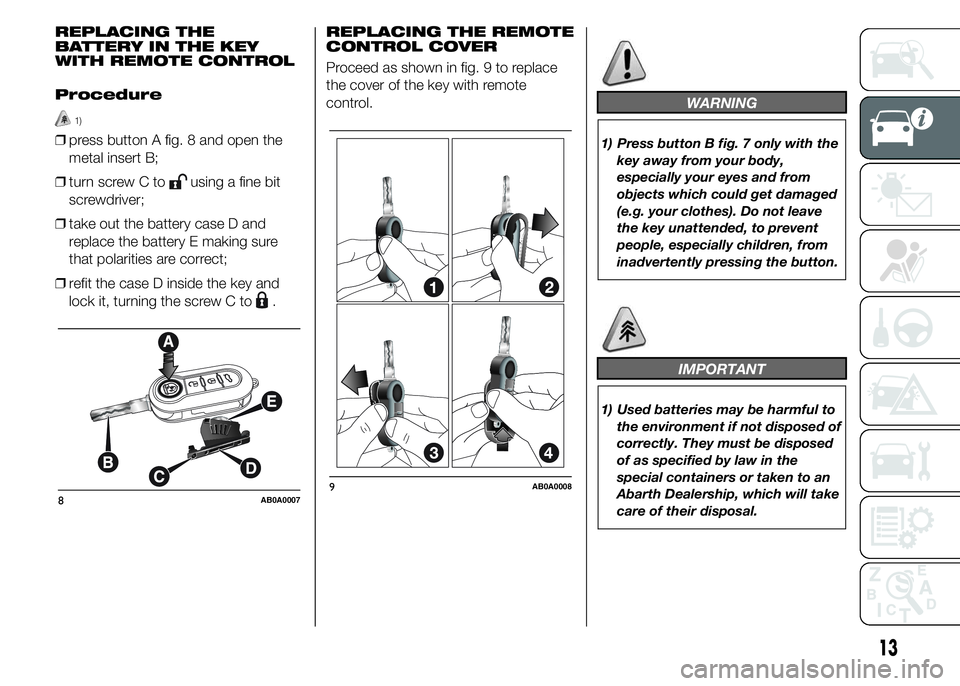
REPLACING THE
BATTERY IN THE KEY
WITH REMOTE CONTROL
Procedure
1)
❒press button A fig. 8 and open the
metal insert B;
❒turn screw C to
using a fine bit
screwdriver;
❒take out the battery case D and
replace the battery E making sure
that polarities are correct;
❒refit the case D inside the key and
lock it, turning the screw C to
.REPLACING THE REMOTE
CONTROL COVER
Proceed as shown in fig. 9 to replace
the cover of the key with remote
control.
WARNING
1) Press button B fig. 7 only with the
key away from your body,
especially your eyes and from
objects which could get damaged
(e.g. your clothes). Do not leave
the key unattended, to prevent
people, especially children, from
inadvertently pressing the button.
IMPORTANT
1) Used batteries may be harmful to
the environment if not disposed of
correctly. They must be disposed
of as specified by law in the
special containers or taken to an
Abarth Dealership, which will take
care of their disposal.
8AB0A00079AB0A0008
13
Page 20 of 215
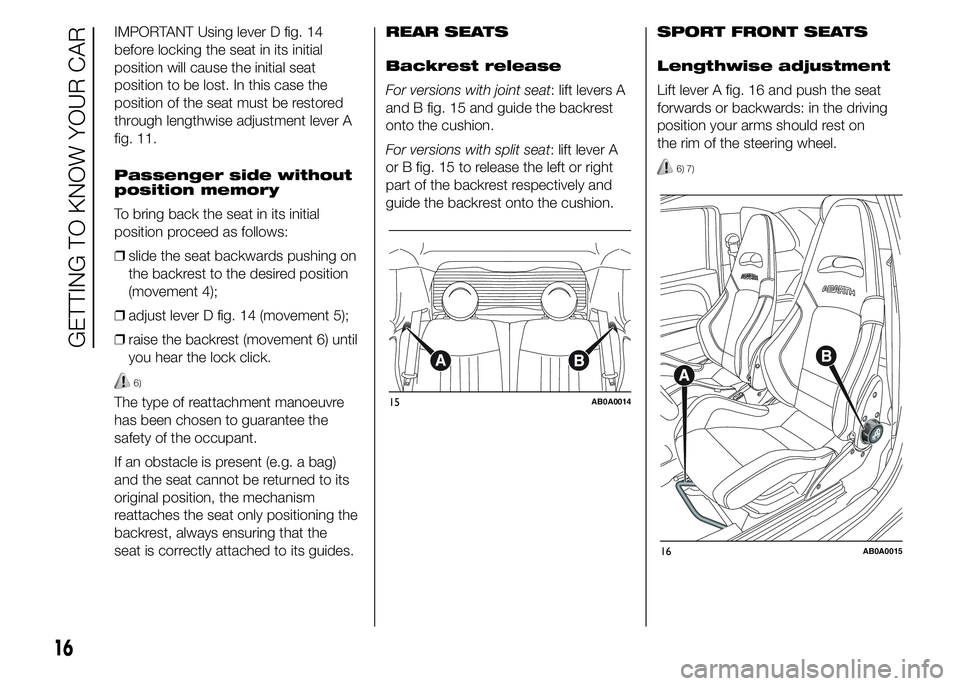
IMPORTANT Using lever D fig. 14
before locking the seat in its initial
position will cause the initial seat
position to be lost. In this case the
position of the seat must be restored
through lengthwise adjustment lever A
fig. 11.
Passenger side without
position memory
To bring back the seat in its initial
position proceed as follows:
❒slide the seat backwards pushing on
the backrest to the desired position
(movement 4);
❒adjust lever D fig. 14 (movement 5);
❒raise the backrest (movement 6) until
you hear the lock click.
6)
The type of reattachment manoeuvre
has been chosen to guarantee the
safety of the occupant.
If an obstacle is present (e.g. a bag)
and the seat cannot be returned to its
original position, the mechanism
reattaches the seat only positioning the
backrest, always ensuring that the
seat is correctly attached to its guides.REAR SEATS
Backrest release
For versions with joint seat: lift levers A
and B fig. 15 and guide the backrest
onto the cushion.
For versions with split seat: lift lever A
or B fig. 15 to release the left or right
part of the backrest respectively and
guide the backrest onto the cushion.SPORT FRONT SEATS
Lengthwise adjustment
Lift lever A fig. 16 and push the seat
forwards or backwards: in the driving
position your arms should rest on
the rim of the steering wheel.
6) 7)
15AB0A0014
16AB0A0015
16
GETTING TO KNOW YOUR CAR
Page 38 of 215
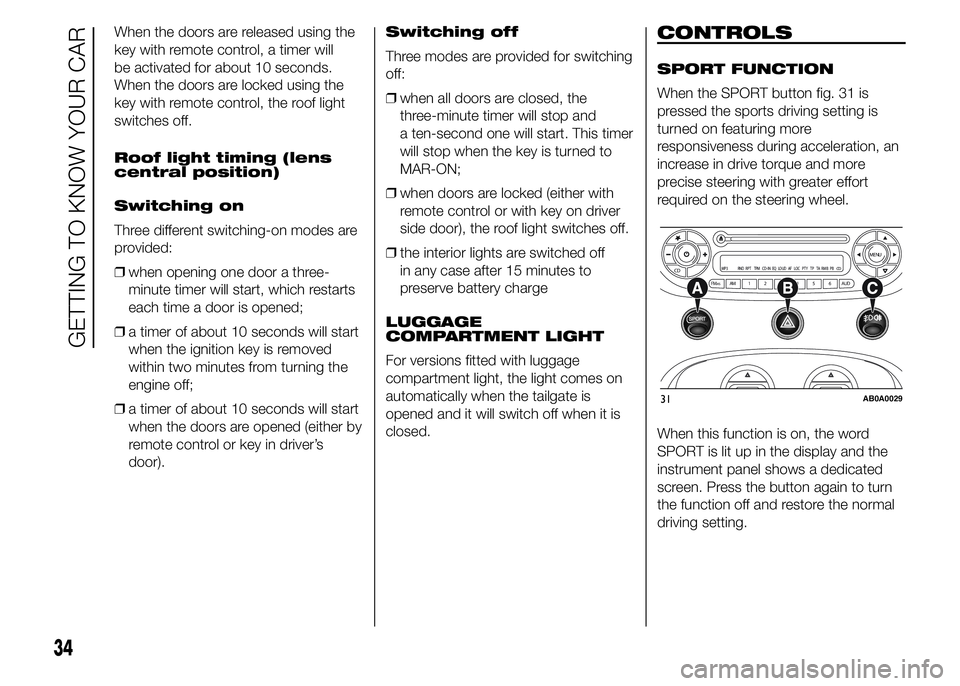
When the doors are released using the
key with remote control, a timer will
be activated for about 10 seconds.
When the doors are locked using the
key with remote control, the roof light
switches off.
Roof light timing (lens
central position)
Switching on
Three different switching-on modes are
provided:
❒when opening one door a three-
minute timer will start, which restarts
each time a door is opened;
❒a timer of about 10 seconds will start
when the ignition key is removed
within two minutes from turning the
engine off;
❒a timer of about 10 seconds will start
when the doors are opened (either by
remote control or key in driver’s
door).Switching off
Three modes are provided for switching
off:
❒when all doors are closed, the
three-minute timer will stop and
a ten-second one will start. This timer
will stop when the key is turned to
MAR-ON;
❒when doors are locked (either with
remote control or with key on driver
side door), the roof light switches off.
❒the interior lights are switched off
in any case after 15 minutes to
preserve battery charge
LUGGAGE
COMPARTMENT LIGHT
For versions fitted with luggage
compartment light, the light comes on
automatically when the tailgate is
opened and it will switch off when it is
closed.CONTROLS
SPORT FUNCTION
When the SPORT button fig. 31 is
pressed the sports driving setting is
turned on featuring more
responsiveness during acceleration, an
increase in drive torque and more
precise steering with greater effort
required on the steering wheel.
When this function is on, the word
SPORT is lit up in the display and the
instrument panel shows a dedicated
screen. Press the button again to turn
the function off and restore the normal
driving setting.
CDMENU
FM ASAM 1 2 3 4 5 6 AUDMP3 RND RPT TPM CD-IN EQ
LOUD AF LOC PTY TP TA RMB PBCD
31AB0A0029
34
GETTING TO KNOW YOUR CAR
Page 44 of 215

FIXED GLASS ROOF
(for versions/markets, where provided)
The roof comprises a wide fixed glass
panel and a manually-operated sun
blind. The blind can be used in the "fully
closed" or "fully open" positions.
To open the blind, grab the handle,
press the tooth A fig. 40 and move it to
the completely open position.
To close it, grab the handle and move
the blind to the closing position until
tooth A is attached.
ELECTRIC SUN
ROOF
(for versions/markets, where provided)
The sun roof comprises a wide
electrically-operated glass panel and a
manually-operated sun blind. The
blind can be used in the "fully closed"
or "fully open" positions.
To open the blind, grab the handle,
press the tooth A fig. 41 and move it to
the completely open position. To close
it, grab the handle and move the blind
to the closing position until tooth A
is attached.OPERATION
The sun roof can be operated only with
the ignition key turned to MAR-ON.
The controls A and B fig. 42 are located
near the front roof light and operate
sun roof closing/opening respectively.
OPENING
Keep the button B fig. 42 pressed: the
roof will move to "spoiler" position.
To fully open the roof press button B
again and hold it down: the roof will
stop in the position reached when the
button is released.
7) 8)
18)
40AB0A0039
41AB0A0039
42AB0A0037
40
GETTING TO KNOW YOUR CAR
Page 50 of 215
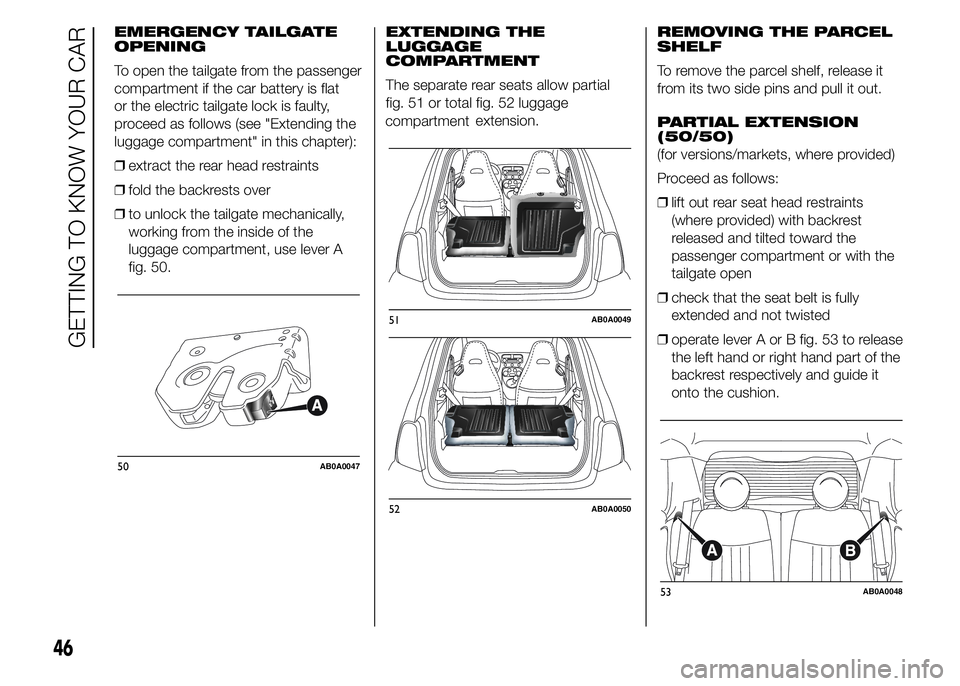
EMERGENCY TAILGATE
OPENING
To open the tailgate from the passenger
compartment if the car battery is flat
or the electric tailgate lock is faulty,
proceed as follows (see "Extending the
luggage compartment" in this chapter):
❒extract the rear head restraints
❒fold the backrests over
❒to unlock the tailgate mechanically,
working from the inside of the
luggage compartment, use lever A
fig. 50.EXTENDING THE
LUGGAGE
COMPARTMENT
The separate rear seats allow partial
fig. 51 or total fig. 52 luggage
extension.REMOVING THE PARCEL
SHELF
To remove the parcel shelf, release it
from its two side pins and pull it out.
PARTIAL EXTENSION
(50/50)
(for versions/markets, where provided)
Proceed as follows:
❒lift out rear seat head restraints
(where provided) with backrest
released and tilted toward the
passenger compartment or with the
tailgate open
❒check that the seat belt is fully
extended and not twisted
❒operate lever A or B fig. 53 to release
the left hand or right hand part of the
backrest respectively and guide it
onto the cushion.
50AB0A0047
51AB0A0049
52AB0A0050
53AB0A0048
46
GETTING TO KNOW YOUR CAR
compartment
Page 54 of 215

ROOF RACK/SKI
RACK
FASTENERS
The fasteners are located in the area
indicated in fig. 57.
To use the front fasteners, remove the
cap A fig. 57, accessible with the door
open.
The rear fixing areas B can be found
according to measurements shown in
fig. 58.
29) 30)
Lineaccessori Abarth provides a
specific roof rack/ski rack for the
tailgate.IMPORTANT Follow the instructions
contained in the assembly kit carefully.
Assembly must be performed by
qualified personnel.
WARNING
29) Strictly adhere to the laws in
force concerning maximum
clearance. Never exceed the
maximum permitted loads; see
chapter "Technical
specifications".
30) Evenly distribute the load and
take into account, when driving,
the increased responsiveness
of the car to side wind. Check that
the attachment fixing screws are
tight after a few kilometres.
57AB0A0054
130 mm30 mm
58AB0A0055
50
GETTING TO KNOW YOUR CAR
Page 57 of 215

EBD (Electronic
Brakeforce Distribution)
SYSTEM
This system (which cannot be
deactivated) recognises emergency
braking conditions according to the
speed of operation of the brake pedal
and provides an additional hydraulic
braking pressure to support that
provided by the driver. This allows
faster and more powerful operation of
the braking system.
ABS
This system, which is an integral part of
the braking system, prevents one or
more wheels from locking and slipping
on all road surface conditions,
irrespective of the intensity of the
braking action, ensuring that the car
can be controlled even during
emergency braking thus optimising
stopping distances.The system intervenes when braking
and the wheels are about to lock,
typically in emergency braking or
low-grip conditions, when locking may
be more frequent.
The system also improves control and
stability of the car when braking on a
surface where the grip of the left and
right wheels varies, or on corners.
System intervention
A slight pulsing of the brake pedal and
noise indicates the intervention of the
ABS: this is completely normal when
the system intervenes
31) 32) 33) 34) 35) 36) 37)
ASR (AntiSlip
Regulation) SYSTEM
This is an integral part of the ESC
system and automatically operates in
the event of one or both drive wheels
slipping, loss of grip on wet roads
(aquaplaning) and acceleration
on slippery, snowy or icy roads, etc.Depending on the slipping conditions,
two different control systems are
activated:
❒if the slipping involves both drive
wheels, the ASR system intervenes,
reducing the power transmitted by
the engine;
❒if the slipping only involves one of the
drive wheels, it also intervenes
automatically, braking the wheel that
is slipping.
System intervention
This is indicated by the flashing of the
warning light on the instrument panel,
to inform the driver that the car is in
critical stability and grip conditions.38) 39) 40) 41)
53
Page 58 of 215

HILL HOLDER SYSTEM
This is an integral part of the ESC
system and facilitates starting on
slopes, activating automatically in the
following cases:
❒uphill: car stationary on a road with a
gradient higher than 5%, engine
running, brake pressed and gearbox
in neutral or gear (other than reverse)
engaged;
❒downhill: car stationary on a road
with a gradient higher than 5%,
engine running, brake pressed and
reverse gear engaged.
When setting off, the ESC system
control unit maintains the braking
pressure on the wheels until the engine
torque necessary for starting is
reached, or in any case for a maximum
of 2 seconds, allowing your right foot
to be moved easily from the brake
pedal to the accelerator.When two seconds have elapsed,
without starting, the system is
automatically deactivated, gradually
releasing the braking pressure. During
this release stage it is possible to hear a
typical mechanical brake release noise,
indicating the imminent movement of
the car.
42) 43)
HBA (Hydraulic Brake
Assist) SYSTEM
This is an integral part of the ESC
system and automatically operates in
the event of one or both drive wheels
slipping, loss of grip on wet roads
(aquaplaning) and acceleration
on slippery, snowy or icy roads, etc.
The HBA system is designed to
improve the car's braking capacity
during emergency braking.
The system detects emergency braking
by monitoring the speed and strength
with which the brake pedal is pressed,
thereby applying the optimal brake
pressure. This can reduce the braking
distance: the HBA system therefore
completes the ABS.Maximum assistance of the HBA
system is obtained pressing the brake
pedal very quickly; in addition, the
brake pedal should be pressed
continuously during braking, avoiding
intermittent presses, to obtain benefits
from the system.
Do not reduce pressure on the brake
pedal until braking is not necessary
anymore.
The HBA system is deactivated when
the brake pedal is released.
44) 45) 46) 47)
MSR (Motor
Schleppmoment
Regelung) SYSTEM
This system is an integral part of the
ABS that intervenes, if there is a
sudden downshifting, restoring torque
to the engine, thereby preventing
excessive drive at the drive wheels
which, especially in poor grip
conditions, could lead to a loss in
stability of the car.
54
GETTING TO KNOW YOUR CAR